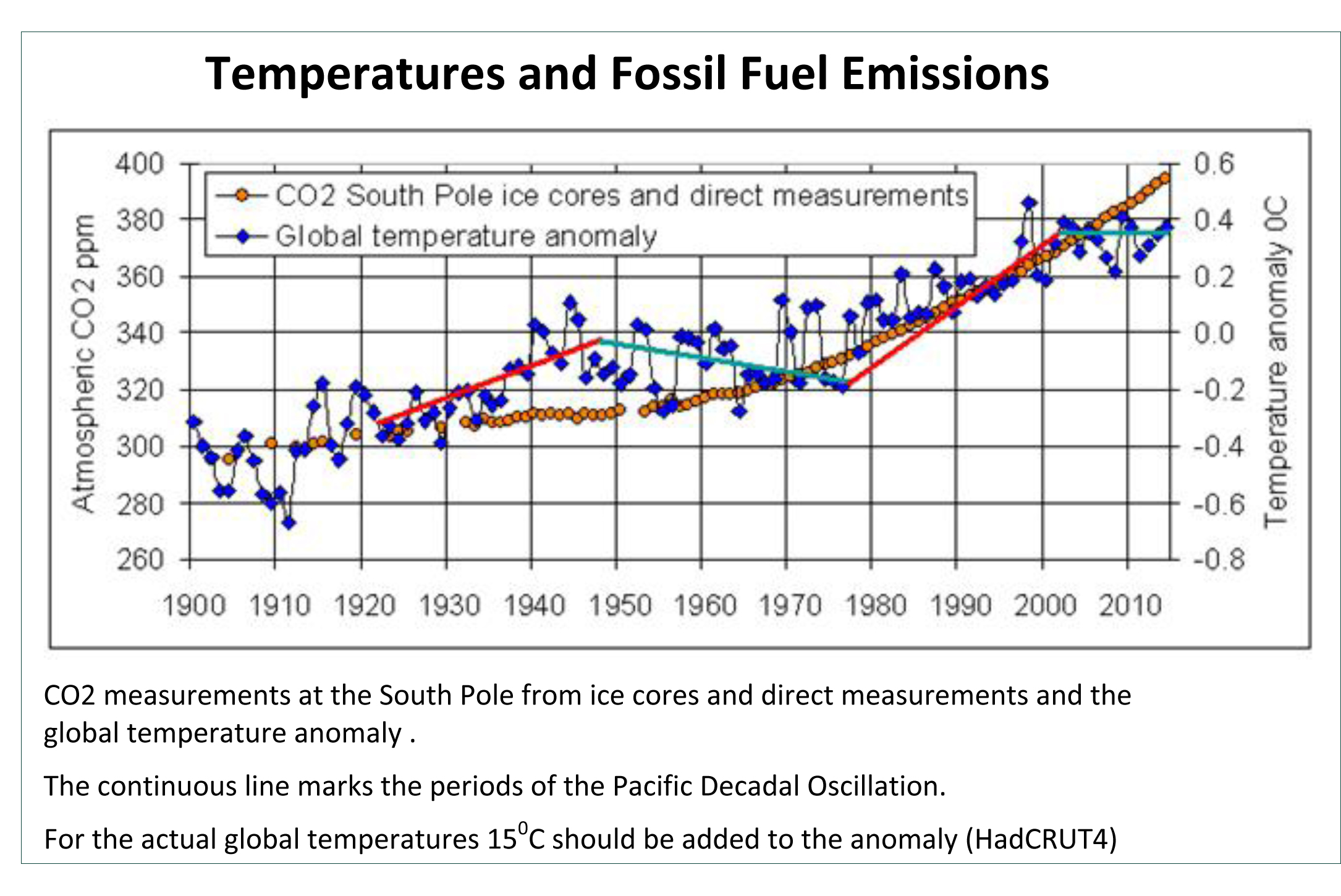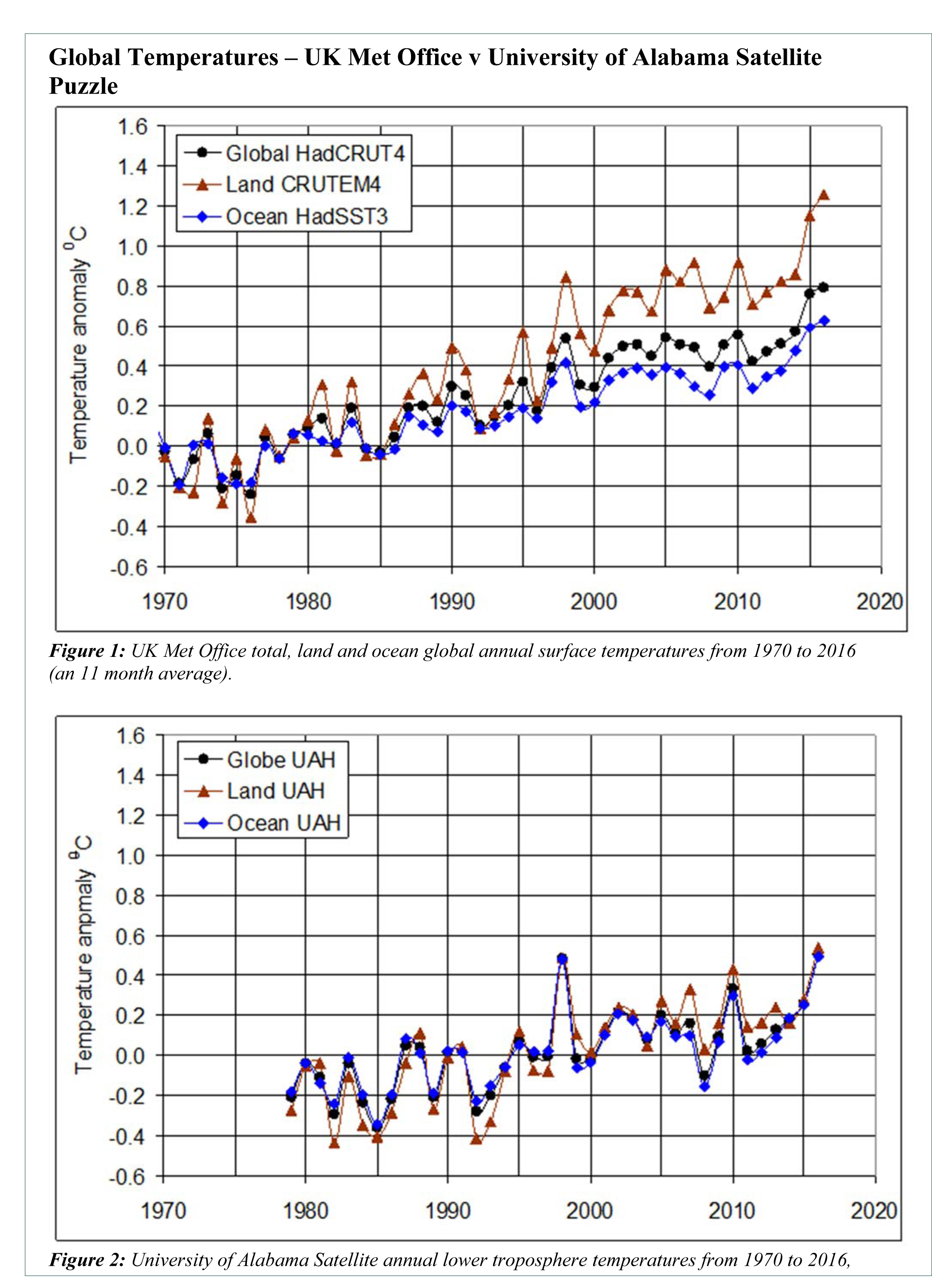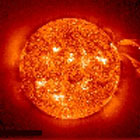 |
|||||||
|
|||||||
|
Latest Analysis of Official Temperatures Suggest Increase Since 1900 Only from 'Natural Drivers' or Errors by Official AgenciesDes MooreAs we watch our TV news showing well below freezing temperatures in parts of Europe, even in Greece, and North America, we are also told by official meteorological agencies that 2016 was one of the warmest years on record. For example, in its report on 2016 the Australian Bureau of Meteorology claims that year was 'Australia's fourth-warmest year on record (the national observational dataset commences in 1910), with Australia's area-averaged mean temperature for 2016 being 0.87 °C above the 1961-1990 average. It also claims that sea surface temperatures in the oceans around Australia were the warmest on record at 0.73 °C above average. The UK Met Office claims that provisional statistics published by it show 2016 as 13th warmest year in the UK (in the series going back to 1910) and that globally 2016 shares the warmest year with 2015. An important question is why there is such a focus by official agencies on the warmist year and whether that phenomenon helps understand the causes of the increase in temperatures published by official agencies. As to the causes, the Australian BOM report acknowledges that 'the Australian climate in 2016 was influenced by a combination of natural drivers and anthropogenic climate change'. But the UK Met mentions neither of these and the Aus BOM does not say anything about the relative contributions made by natural drivers and human activity. We can say however that, even if temperatures have increased by about 0.8C since around 1900 (which is the standard official message), this has done no harm. To the contrary, as illustrated in this report by the FAO, 2016 produced record agricultural output and since 1900 there has been a strong increase in food and other consumer production, with poverty rates falling. This suggests that, even if CO2 emissions did contribute to increased temperatures, there is no need to reduce the CO2 concentrations which remain in the atmosphere as a result human activity to date. Indeed, given that the increase in published temperature of 0.8C since about 1900 has done no harm, it also suggests there is no substantive basis for the government to justify taking action to reduce emissions from hereon unless it can be established that major increases in temperatures will now occur and damage production capacity.
We also know that during the period from the late 1970s to around 2000 a major natural driver did occur in the form of the Pacific Decadal Oscillation (see continuous line in graphs on Temperatures and Fossil Fuel Emissions). This sudden replacement of cold water with warm water along the western Pacific Coast of the North Americas was accompanied by increases in published global temperatures of about 0.4C. This suggests that a considerable proportion of the published temperature increase since 1900 reflected a 'natural driver'. Further, the graph indicates that from the late 1940s until the late 1970s there was a downward trend in temperatures even though emissions of CO2 (and the proportion staying in the atmosphere) increased. No satisfactory explanation has been provided of why temperatures did not increase.
Beyond all this, there is substantial evidence suggesting that the temperature figures published by official agencies contain significant errors with an upwards bias. This can be seen by examining the marked differences between the increase in temperatures published by the official agencies and the increase published by the University of Alabama (UAH). The official agency figures are derived from individual stations measuring land surface temperatures and the sampling of water temperatures in measuring ocean temperatures but the UAH figures are derived from satellite measurements taken in the lower troposphere. There should be no significant difference between the increases shown by the UAH and those published by official agencies. But, as indicated in the attached graphs comparing the increases over the 1979 to 2016 period, there is in fact at least one major difference - see the Global Temperatures - UK Met Office v University of Alabama Satellite Puzzle. In the case of the global measurement of increases in land temperature, the increase since 1979 published by the UK Met Office (whose data is used by the IPCC) is 1.1-1.2 of a degree while the increase published by UAH is about 0.0-0.5 of a degree (the figures for 2016 are probably at only a temporary high because they were lifted by the 'natural driver' El Nino in that year). It could legitimately be asserted that, whatever comparison is used, the official agency figures show increases around 0.4C of a degree higher on land temperature than the UAH ones. But (remarkably) there are very small differences between the two in the case of increases in ocean temperatures. Both show increases in ocean temperatures since 1979 of about 0.6 of a degree. It is difficult to explain why the land increases are so different while the ocean increases are similar. But the most likely explanation is that the official agencies have limited scope to adjust their ocean temperatures (now taken mainly from buoys but with only limited coverage) whereas there is considerable opportunity to do so, or not to do so, with their land temperatures. In the latter case an examination of maximum and minimum temperatures published for some individual stations indicates that increases which reflect urban heating are not deducted. It also appears that there has been an incorrect calculation of the average temperatures in some stations and this has wrongly raised temperatures there. In addition, the adjustments made to temperatures at some stations because of changes in the method of recording temperatures also appear to have an upward bias. Overall, the various adjustments or non-adjustments could well account for the estimate of an 0.4C of a degree upward bias referred to in the previous paragraph (further background on this estimate can be found in papers on my web site). This means that with the likely increase of 0.4C of a degree due to the 'natural driver', and the further increase of 0.4C of a degree from wrongful adjustments or failures to adjust by official agencies, there has actually been little or no increase in global temperatures since 1900. It also means that Australia's official agency should be required to publish its view of the effect of 'natural drivers' and to respond to the many analyses suggesting an upward bias in its published figures (the review started last year appears to have been undertaken by people with only limited knowledge of the adjustments or failures and ,in any event, was postponed to some time this year). Targets Set for Usage of Renewable EnergyNotwithstanding the foregoing analysis (the basis of which is now widely accepted outside official sources), just about every Western government continues to accept the 0.8C increase in global temperature since 1900. Also accepted by such governments is the thesis that, unless action is taken to reduce the emissions of CO2 which emanate from energy from usage of fossil fuels (mainly coal and oil, some from gas), temperatures will increase to dangerous levels. In previous Commentaries I have suggested that once the Obama Presidency is over there may be an opportunity to abandon restrictions on emissions of CO2, let alone targets for usage of renewable sources. With climate-sceptic Trump shortly to become US President, there is now a real possibility that the US will abandon both its own restrictive emissions policies and its support for such policies at international fora. However, Australian governments are yet to recognise this and are continuing to increase their resort to renewable energy sources (mainly wind and solar power). Some (including the Turnbull government) have set targets for the usage of renewable sources, including up to 50 per cent. Such sources are much more costly to use and this is forcing totally unnecessary increases in electricity prices paid by businesses and households. Yet, as with the acceptance of the 0.8C temperature increase, there was no prior independent assessment of the use of renewable energy and it has taken the blackouts in South Australia to persuade governments to review that decision. But that review seems mainly to be being undertaken by a Chief Scientist who has no background on climate change issues. As such, it will not have credibility unless it includes experts who have experience in analysing such issues. [Note: Physicist Dr Tom Quirk has provided considerable assistance particularly in constructing the graphs]
|
|
|





